The Science of Flavor: What Makes Wagyu So Delicious?
Wagyu beef is often hailed as one of the finest meats in the world, and for good reason. Its rich marbling, melt-in-your-mouth texture, and intense flavor profile make it a truly unique culinary experience. But what exactly makes Wagyu so delicious? It’s not just the quality of the beef—it’s the science behind its flavor, texture, and sensory experience. In this post, we break down the key factors that contribute to the unrivaled taste of Wagyu, from the umami to the texture that sets it apart from other meats.
1. Umami: The Fifth Taste
Wagyu’s flavor profile is dominated by umami, often referred to as the "fifth taste" alongside sweet, sour, salty, and bitter. Umami is a savory, rich taste that adds depth and complexity to food. It’s primarily derived from the amino acid glutamate, which is abundant in Wagyu beef. The high level of marbling (intramuscular fat) found in Wagyu is rich in these umami compounds, contributing to the beef's deep, savory flavor.
When you take a bite of Wagyu, the fat melts beautifully in your mouth, releasing those umami compounds and creating a flavor explosion that is both satisfying and incredibly nuanced. This depth of flavor is what gives Wagyu its luxurious, one-of-a-kind taste.
2. The Role of Marbling: Texture and Taste
The marbling in Wagyu beef is what gives it its signature tenderness and melt-in-your-mouth texture. Unlike traditional beef, where fat is dispersed around the muscle, Wagyu has a high degree of intramuscular fat. This fat is finely distributed, creating a uniform texture that’s rich and buttery. As the meat cooks, the fat melts into the muscle fibers, infusing the meat with flavor and making it incredibly tender.
When you take a bite, you’ll notice how the texture of Wagyu is both soft and juicy. The fat provides a luxurious mouthfeel, while the muscle fibers remain tender yet firm, creating a perfect balance between the two. This unique combination of texture and flavor is what elevates Wagyu to the top tier of luxury meats.
3. Aroma: The Sensory Experience Begins Before the First Bite
The experience of eating Wagyu starts before the first bite, with the aroma. When you sear a Wagyu steak, the fat begins to caramelize, releasing a savory, slightly sweet smell that’s incredibly appetizing. This aroma signals the complex flavors about to unfold, enhancing the overall sensory experience.
As the beef cooks, its aroma fills the room, building anticipation for the first taste. The fragrance itself is an integral part of the flavor experience, as our sense of smell is closely linked to our ability to taste and appreciate food.
4. The Melting Point of Wagyu Fat
Wagyu’s fat has a lower melting point than traditional beef fat, which allows it to melt at a lower temperature, releasing its rich, buttery flavor as it cooks. This contributes to the signature "melt-in-your-mouth" experience that Wagyu is known for. As the fat melts, it coats the palate, enhancing the overall taste and leaving a lingering, delicious aftertaste that’s hard to forget.
5. The Perfect Balance: A Symphony of Taste and Texture
Wagyu is not just about one flavor or texture—it’s the perfect harmony of multiple sensory experiences. From the umami richness to the delicate marbling and melt-in-your-mouth texture, each bite of Wagyu is a symphony of flavors and sensations. It’s the balance of these elements that makes Wagyu so universally adored, and why it’s considered a true delicacy.
Related Posts
How We Select and Age Our Wagyu Beef for Optimal Flavor
Learn about the process of selecting and aging Wagyu beef at Plum Creek Wagyu. Discover the differences between dry-aging and wet-aging and how each method enhances the flavor and tenderness of our premium Wagyu cuts.
How We Select and Age Our Wagyu Beef for Optimal Flavor
Learn about the process of selecting and aging Wagyu beef at Plum Creek Wagyu. Discover the differences between dry-aging and wet-aging and how each method enhances the flavor and tenderness of our premium Wagyu cuts.
Sustainable Ranching at Plum Creek Wagyu: Our Eco-Friendly Practices
Discover Plum Creek Wagyu’s commitment to sustainability and eco-friendly ranching practices. Learn about our efforts in land stewardship, water conservation, and reducing our carbon footprint to produce premium Wagyu beef responsibly.
Behind-the-Scenes at Plum Creek Wagyu: From Pasture to Plate
Discover the life cycle of a Plum Creek Wagyu cow, from birth to plate. Learn about the care, feeding, and stress-free environment that contributes to the exceptional quality of our Wagyu beef.
Wagyu Beef vs. Kobe Beef: What’s the Difference?
Curious about the difference between Wagyu and Kobe beef? Learn how these two premium beef types differ in terms of origin, quality, and flavor, and discover why Kobe beef is considered the gold standard of luxury dining.
The Science Behind Wagyu Marbling: Why It’s So Special
What makes Wagyu beef so incredibly tender and flavorful? The secret lies in its marbling. Discover the science behind Wagyu’s signature fat distribution and why it creates the ultimate steak experience.








